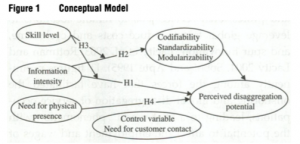Week 11_Mithas and Whitaker (2007)_Vicky Xu
Is the World Flat or Spiky? Information Intensity, Skills, and Global Service Disaggregation
Mithas and Whitaker (2007) developed the previous research (Apte and Mason1995, Rai et al. 2006) to a theory of service disaggregation and identified the codifiability, standardizability, and modularizeability of an occupation as mediating mechanisms for the effect of information intensity on the global disaggregation of services. Moreover, Mithas and Whitaker (2007) studied the patterns in U.S. employment and salary growth from 2000 to 2004.
Mithas and Whitaker (2007) addressed two main research questions in this study:
(1). Which service occupations are the most susceptible to global disaggregation?
(2). What are the factors and mechanisms that make service occupations amenable to global disaggregation?
By extending Apte and Mason’s conceptual research, Mithas and Whitaker (2007) presented a conceptual research model as the following (Figure 1, P. 238):
Combining data from all different separate sources, Mithas and Witaker (2007) used ordinary least squares (OLS) to analyze 322 observations for which they had data on all variables. There are several findings in this study: (1) A positive association between information intensity and perceived disaggregation potential. (2) A negative association between the need for physical presence and perceived disaggregation potential. (3) A positive, statistically significant association between the need for physical presence and employment growth and a negative, statistically significant between the need for physical presence and salary growth. (4) High information-intensive and high-skill occupations have actually experienced higher employment growth. (5) High information-intensive and high-skill occupations have experienced a slight decline in salary growth.
The key contributions of this study include: First, this study contributes to an understanding of the global disaggregation of service activities by identifying the factors and mechanisms which extending the research of Apte and Mason (1995) and Rai et al. (2006). Second, the findings of this study suggest two important policy and managerial implications.



Leave a Reply
You must be logged in to post a comment.